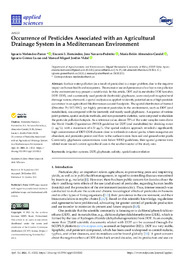Título :
Occurrence of Pesticides Associated with an Agricultural
Drainage System in a Mediterranean Environment |
Autor :
Melendez-Pastor, Ignacio 
Hernández, Encarni I.
Navarro-Pedreño, Jose
Almendro-Candel, María Belén
Gómez Lucas, Ignacio
Jordán-Vidal, Manuel Miguel |
Editor :
MDPI |
Departamento:
Departamentos de la UMH::Agroquímica y Medio Ambiente |
Fecha de publicación:
2021-10 |
URI :
https://hdl.handle.net/11000/34636 |
Resumen :
Surface water pollution (as a result of pesticides) is a major problem, due to the negative
impact on human health and ecosystems. The excessive use and persistence of surface water pollution
in the environment may present a notable risk. In this article, DDT and its metabolite DDE hereafter,
DDT–DDE), and a commonly used pesticide (herbicide) glyphosate, were analyzed in agricultural
drainage waters; afterward, a spatial analysis was applied to identify potential areas of high pesticide
occurrence in an agricultural Mediterranean coastal floodplain. The spatial distribution of banned
(Directive 79/117/EEC), yet highly persistent pesticides in the environment, such as DDT (and
metabolites), was compared with the (currently and mostly used) glyphosate. A sequence of various
point patterns, spatial analysis methods, and non-parametric statistics, were computed to elucidate
the pesticide pollution hotspots. As a reference value, almost 70% of the water samples were above
the World Health Organization (WHO) guideline for DDT (and metabolites) for drinking water
(1 g/L), with a maximum of 6.53 g/L. Our spatial analysis approach revealed a significantly
high concentration of DDT–DDE clusters close to wetlands in natural parks, where mosquitos are
abundant, and pesticides persist and flow to the surface waters from soil and groundwater pools.
Conversely, glyphosate concentrations were below WHO guidelines; their spatial patterns were
related more toward current agricultural uses in the southern sector of the study area.
|
Palabras clave/Materias:
irrigation systems
DDT
glyphosate
salinity
spatial autocorrelation |
Área de conocimiento :
CDU: Ciencias aplicadas: Ingeniería. Tecnología |
Tipo de documento :
info:eu-repo/semantics/article |
Derechos de acceso:
info:eu-repo/semantics/openAccess
Attribution-NonCommercial-NoDerivatives 4.0 Internacional |
DOI :
https:// doi.org/10.3390/app112110212 |
Publicado en:
Applied Sciences, 2021, 11, 10212 |
Aparece en las colecciones:
Artículos Agroquímica y Medio Ambiente
|
 La licencia se describe como: Atribución-NonComercial-NoDerivada 4.0 Internacional.
La licencia se describe como: Atribución-NonComercial-NoDerivada 4.0 Internacional.
.png)
